Physical Address
304 North Cardinal St.
Dorchester Center, MA 02124
Physical Address
304 North Cardinal St.
Dorchester Center, MA 02124
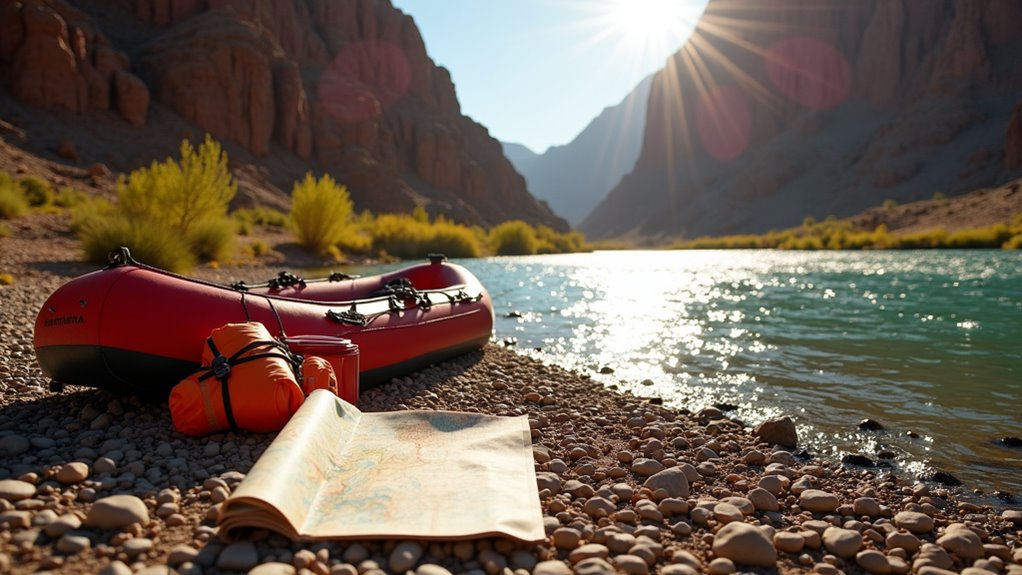
Master the art of self-guided Snake River rafting, saving thousands while creating an unforgettable adventure on your own terms.
Over 300,000 adventurers navigate the Snake River each year, yet fewer than 10% plan their own self-guided trips. You’ll find that organizing your own rafting expedition can save you up to 60% compared to guided tours while offering complete control over your journey’s pace and stops. From securing permits to selecting the right gear, there’s a systematic approach to crafting your perfect river experience. Let’s explore how you can join the savvy minority who master their own Snake River adventure.
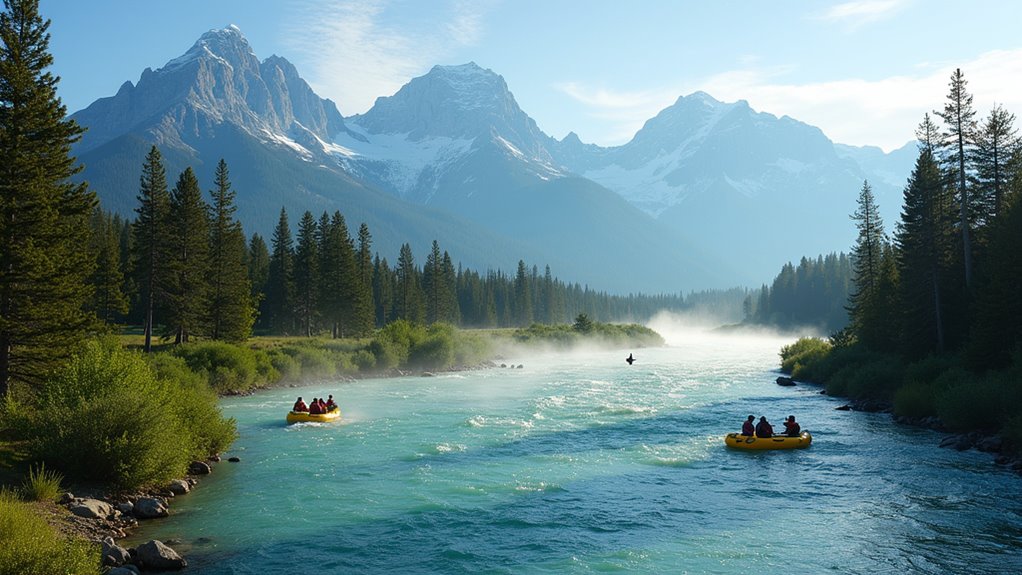
When planning a Snake River rafting adventure, you’ll need to carefully consider both trip duration and seasonal timing to maximize your experience while staying within budget.
If you’re new to rafting or traveling with young children, start with a 2.5-4 hour scenic float during July through September when waters are calmer and temperatures warmer.
For a deeper wilderness experience, consider 3-6 day expeditions through Hells Canyon, which offer excellent value with included meals and camping. The pre-set camps provide spacious tents and comfortable amenities ready upon your arrival.
Book these longer trips between May and June if you’re seeking more challenging whitewater, or later in summer for milder conditions and swimming opportunities.
Match your chosen timeframe with your skill level – early season requires more advanced abilities due to higher water flows, while late summer trips accommodate all experience levels.
A well-planned rafting trip starts with the right gear and equipment, which can make the difference between an enjoyable adventure and a miserable experience.
You’ll need essential clothing like water shoes, swimsuits, and a light jacket for temperature changes. Don’t forget personal safety items, including sunscreen, UV-protective sunglasses, and a waterproof first aid kit.
For camping, pack a large waterproof bag for your belongings and a smaller day bag for items you’ll need while rafting. Your gear bag will include sleeping essentials like a sleeping bag, sheet, and ground tarp. Check if your outfitter provides life jackets and camp chairs.
Stay hydrated with water bottles and bring camping water filters to purify the river water. Consider packing a waterproof camera to capture memories, and don’t forget a headlamp for nighttime activities.
Most items can be stored in waterproof bags to keep them dry.
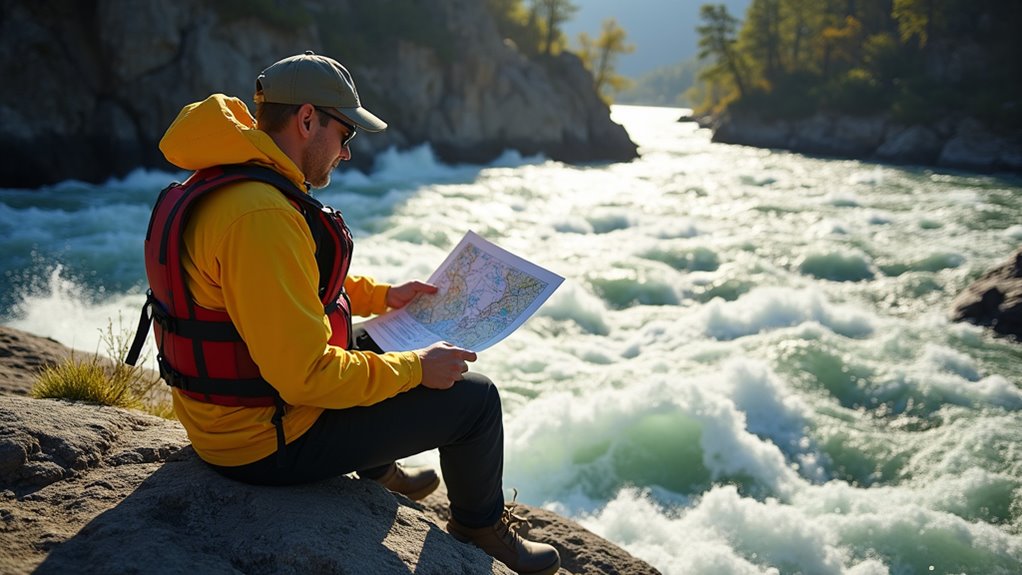
Beyond having the right equipment, knowing how to read and navigate different river classifications forms the backbone of a safe rafting experience.
The Snake River primarily features Class II to IV rapids, which means you’ll encounter varying levels of challenge. Class II rapids offer gentle waves requiring basic maneuvering – perfect if you’re a beginner. During spring runoff periods, water levels can increase the difficulty of rapids significantly. Hypothermia risks are also a major concern during the winter months.
From gentle Class II waves perfect for beginners to challenging Class IV rapids, the Snake River offers adventures for every skill level.
When you progress to Class III sections, you’ll need sharper paddling skills to handle moderate waves and small drops.
If you’re tackling Class IV rapids, you must scout ahead and prepare for intense water conditions. Always check current water levels before your trip, as they can alter rapid classifications.
Don’t attempt anything beyond your skill level, and be ready to portage around particularly challenging sections. Remember to coordinate with your group and practice rescue techniques before attempting more difficult rapids.
Choosing the right campsite along the Snake River involves three key decisions: location type, amenities needed, and accessibility requirements. You’ll find options ranging from developed campgrounds with full facilities to primitive dispersed sites for a more rugged experience.
If you’re seeking comfort, look for developed campgrounds like Station Creek, which offers picnic tables, fire rings, and potable water. These sites typically sit at 5,800 feet elevation and provide vault toilets and food storage lockers. Families can also opt for Deluxe Cabins that accommodate up to 8 people and feature private bedrooms and kids’ lofts.
For RV camping, you’ll find full hookup sites near Jackson Hole that can accommodate vehicles up to 30 feet. Essential gear for your next camping adventure can help ensure a comfortable and successful trip.
Remember to check current fire restrictions and reserve early for group sites, which can host up to 40 people. Most locations operate on a first-come, first-served basis, and you must camp in designated areas to protect the river’s ecosystem.
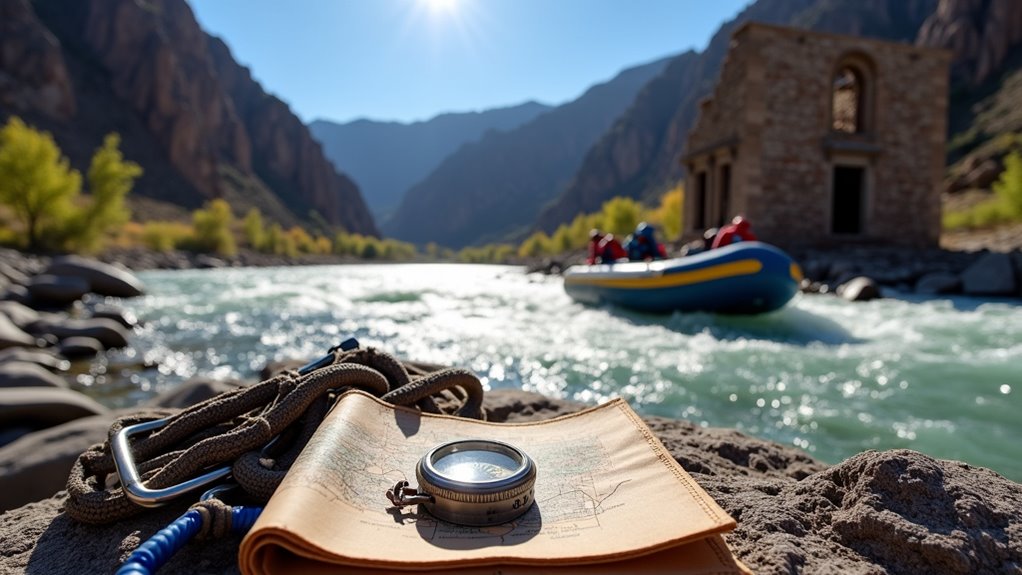
While planning your Snake River rafting adventure, you may wish to explore the affluent history and remarkable landmarks that define this iconic waterway.
Don’t miss Shoshone Falls, known as the “Niagara of the West,” where you’ll find the river’s deepest point and excellent hiking trails. A visit to Kirkwood Historic Ranch offers fascinating glimpses into Idaho’s sheep ranching heritage through its preserved shearing shed, cabins, and blacksmith workshop. The historic Perrine Bridge, standing 486 feet high, offers spectacular views and BASE jumping opportunities.
Towering 212 feet high, majestic Shoshone Falls cascades dramatically over ancient rock, creating Idaho’s most awe-inspiring natural wonder.
You’ll want to follow the path of pioneering explorers like Amos Burg, who first conquered the full river length in 1925.
Stop at the Morely Nelson Snake River Birds of Prey National Wildlife Refuge to spot nesting raptors, including bald eagles and peregrine falcons.
For whitewater enthusiasts, Hells Canyon’s famous rapids, like “Wild Sheep” and “Granite,” provide thrilling challenges amid North America’s deepest river gorge.
Maneuvering the permit system for Snake River rafting requires careful attention to timing and location.
You’ll need different permits depending on your launch point and season, with primary season (Memorial Day-September 10) requiring advance lottery reservations through Recreation.gov, while secondary season allows self-issued permits at river portals. Many rafters choose to launch from Pittsburg Landing, which offers convenient river access.
Three critical permit requirements to remember:
If you’re planning overnight camping on the South Fork, obtain a free permit at the boat ramps or online.
For Grand Teton sections, you’ll need additional non-motorized boat permits from visitor centers.
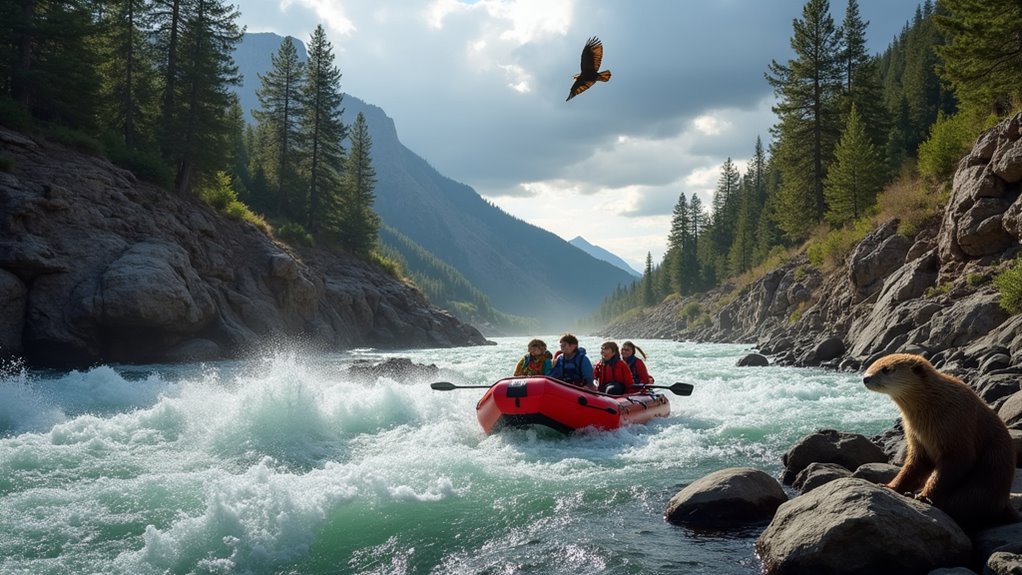
Because the Snake River hosts one of North America’s densest bald eagle populations, you’ll find exceptional wildlife photography opportunities throughout your rafting journey.
Pack a telephoto lens to capture eagles diving for fish, mating pairs in flight, and hawks hunting along the riverbanks.
A powerful telephoto lens reveals nature’s drama: eagles plunging for prey, soaring pairs, and hawks prowling the river’s edge.
The stretch between Wilson Bridge and South Park Bridge offers your best wildlife viewing chances. In addition, the Snake River is home to a variety of other wildlife species.
You’ll spot native cutthroat trout in clear waters, while beavers construct lodges among old-growth cottonwoods.
Watch for deer, mink, and river otters along the shoreline, especially during morning and evening hours.
For the best shots, plan to photograph during overcast days when soft light reduces harsh shadows.
Stay patient and maintain a respectful distance from wildlife.
Bring waterproof camera gear to capture both above and underwater action.
Your Snake River rafting adventure doesn’t have to break the bank or leave you unprepared. With careful planning, proper permits, and well-chosen gear, you’ll navigate this serpentine wonder like a seasoned pro. Whether you’re gliding through peaceful stretches or tackling challenging rapids, your self-guided trip can be as wild or mild as you choose. Pack smart, stay safe, and let the river’s ancient rhythm guide your journey.